A cozy fireplace creates a warm and inviting atmosphere during chilly nights, providing comfort and relaxation. However, to fully enjoy your fireside experience, choosing the right wood for your fireplace is essential. The type of wood you select can significantly impact the quality of your fire, its efficiency, and even the safety of your home. So, what is the best wood for fireplace?
| Wood Species Type | Million BTU’s per cord | Smoke % |
|---|---|---|
| Beech Blue | 26.8 | 4% |
| Oak | 25.7 | 5% |
| Maple | 24 | 7% |
| Cherry | 20 | 9% |
| Ash | 19.9 | 7% |
| Birch | 20.3 | 9% |
| Douglas Fir | 18.1 | 11% |
| Apple | 26.5 | 7% |
| Pear | 27.9 | 5% |
This comprehensive guide explores the best wood options for your fireplace, considering burn time, heat output, and overall ambiance. Let’s delve into the firewood world and discover which types are best for your fireplace.
Best Wood For Fireplace With Maximum Heat And Less Smoke
- Beech Blue: 26.8 MBTU/cord; Smoke 4%
- Oak: 25.7 MBTU/cord; Smoke 5%
- Maple: 24 MBTU/cord; Smoke 7%
- Cherry: 20 MBTU/cord; Smoke 9%
- Ash: 19.9 MBTU/cord; Smoke 7%
- Birch: 20.3 MBTU/cord; Smoke 9%
- Douglas Fir: 18.1 MBTU/cord; Smoke 11%
- Apple: 26.5 MBTU/cord; Smoke 7%
- Pear: 27.9 MBTU/cord; Smoke 5%
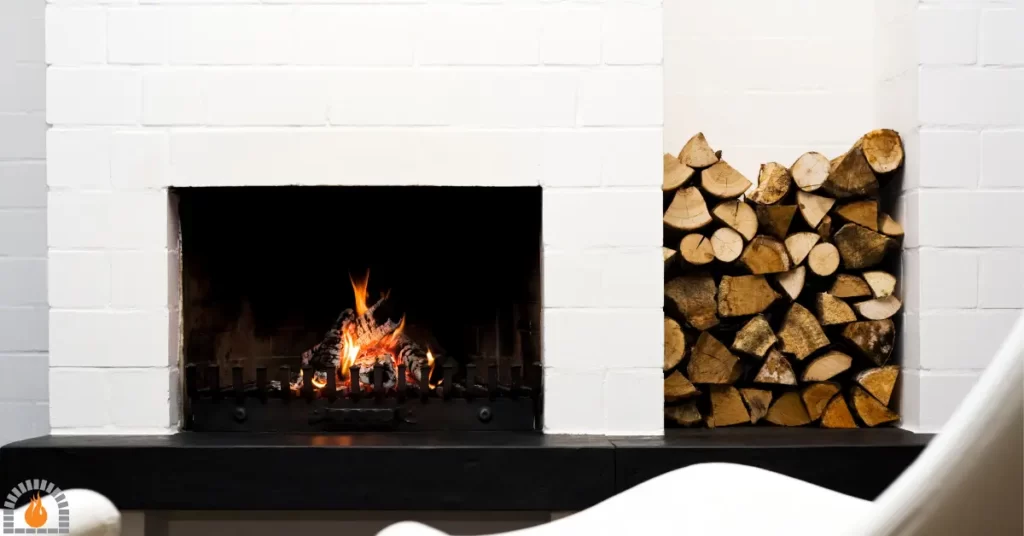
Understanding Firewood Basics
To make an informed decision, it’s crucial to understand the basic characteristics of firewood. Firewood is typically categorized based on its density, moisture content, and the type of tree it comes from.
These factors influence burn time, heat output, and the overall performance of the firewood in your fireplace.
Hardwood vs. Softwood
The Fundamental Difference Regarding firewood, two main categories exist: Hardwood and softwood.
Hardwood comes from deciduous trees such as oak, maple, or birch, while softwood originates from coniferous trees like pine, spruce, or fir. Hardwood and softwood have distinct qualities that suit different fireplace needs.
Green Wood vs. Seasoned Wood
Green Wood
Greenwood refers to freshly cut or recently harvested wood that has not been dried. Depending on the species and environmental conditions, it contains a high moisture content, typically above 30% or even higher.
When burning green wood, a significant amount of energy evaporates the water within the wood before it can generate heat.
This means that green wood produces less heat and more smoke than seasoned wood.
Burning green wood can lead to creosote buildup in chimneys, posing a fire hazard.
Seasoned Wood
Seasoned wood has been dried to reduce its moisture content to a suitable level for burning efficiently. The drying process typically involves storing the wood in a well-ventilated area for an extended period, allowing the moisture to evaporate.
Seasoned wood generally has a moisture content of around 20% or less, making it more suitable for use as firewood. It produces more heat and less smoke than green wood, resulting in a cleaner and more efficient burn.
Seasoned wood is also lighter and easier to handle than green wood.
The Advantages of Hardwood
Hardwood is widely considered the superior choice for firewood due to its many advantages. Hardwoods burn longer, produce more heat, and create a steady and consistent fire.
They tend to have a higher density, allowing them to release heat over an extended period. Popular hardwoods for fireplaces include oak, maple, and hickory.
The Benefits of Softwood
While softwood may not offer the same extended burn time as hardwood, it has unique advantages. Softwoods ignite quickly, making them ideal for starting a fire or creating a burst of heat.
They are also more readily available and often less expensive than hardwoods. Softwoods like pine or spruce can be combined with hardwoods to achieve the desired balance of burn time and heat output.
Best Wood For Fireplace
1) Beech Blue Wood
Characteristics:
- Density: Beech blue wood has a high density, which means it burns slowly and produces long-lasting heat. This makes it an efficient choice for heating purposes.
- Heat Output: Has a good heat output, providing a warm and cozy ambiance in your fireplace. Its high BTU rating ensures a significant amount of heat is generated when burned.
- Flame Appearance: Produces beautiful flames with a vibrant orange glow when burning. This adds to the aesthetic appeal of your fireplace and creates an inviting atmosphere.
- Coaling Ability: Beech wood forms a good bed of coals when burned. These coals retain heat for an extended period, allowing you to maintain a steady temperature in your fireplace.
- Smoke Production: Beech wood generally produces minimal smoke compared to other types of firewood. This results in cleaner and healthier indoor air quality.
- BTU Rating: Beechwood typically has a BTU rating of approximately 26.8 MBTU/cord. The exact BTU value may vary depending on the moisture content and the specific condition of the wood.
- Smoke Percentage: Has a relatively low smoke percentage when burned. The smoke produced is usually minimal, reducing emissions and less pollution.
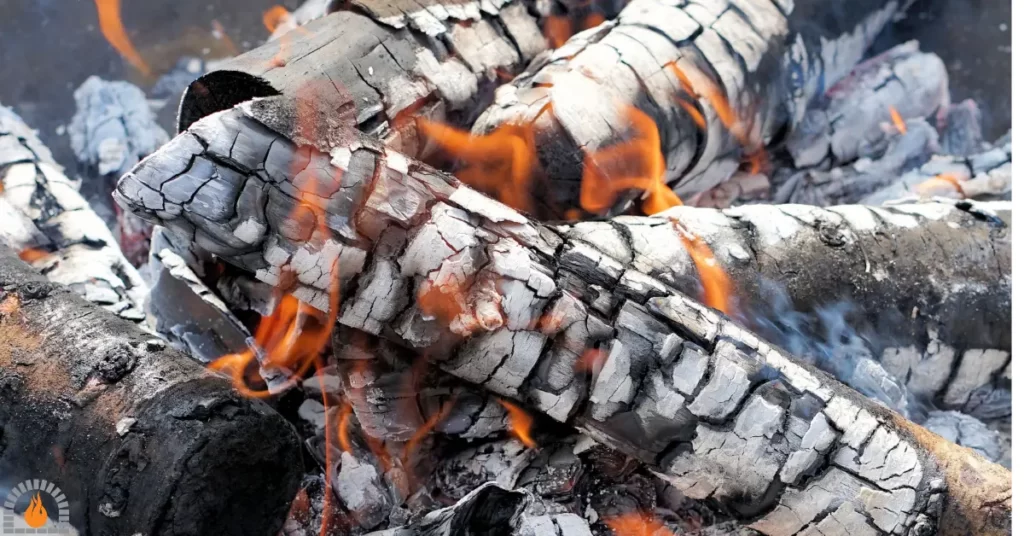
2) Oak Wood
Characteristics:
- High Energy Content: Oak wood is renowned for its high heat output. It has a high BTU (British Thermal Unit) rating, which measures the heat produced by burning a particular type of wood. On average, Oak wood has a BTU rating of approximately 25.7 MBTU/cord.
- Slow and Steady Burn: Oak wood burns slowly and steadily, providing a long-lasting and consistent heat source. It can sustain a fire for an extended period, making it ideal for heating.
- Intense and Radiant Heat: When Oak wood burns, it produces a significant amount of radiant heat. This means it emits a comfortable warmth that can efficiently heat a room, making it a popular choice for heating homes during colder months.
- Minimal Sparking: Oak wood is relatively resistant to sparking compared to other firewood types. This makes it safer to use in indoor fireplaces, reducing the risk of sparks escaping and potentially causing accidents.
- Subtle Aroma: Oak wood has a pleasant, subtle aroma when burned, which adds to the overall ambiance of the fire. Many people enjoy the natural scent that Oak wood imparts while it burns.
- Low Smoke: Oak wood produces less smoke than softer woods, such as pine or spruce. However, it’s important to note that the smoke production can still vary depending on the moisture content and wood quality.
- Coaling Properties: Oak wood creates long-lasting coals when burned, which can help maintain a fire and provide sustained heat even after the initial flames have subsided. These glowing coals are ideal for cooking or maintaining a warm fire overnight.
3) Maple Wood
Characteristics:
- BTU Output: Maple wood has a high heat value, measured in British Thermal Units (BTU). On average, Maple wood produces around 24 MBTU/cord. This high BTU output makes Maple wood an excellent choice for generating warmth and providing a cozy fire.
- Energy Efficiency: Maple wood is known for its energy efficiency as a burning wood. It burns slowly and steadily, releasing heat consistently over a longer period. This means that Maple wood can provide warmth for an extended duration, reducing the need for constant refueling of the fireplace.
- Long Burning Time: Maple wood offers a long burning time due to its density and slow-burning properties. This characteristic is beneficial as it reduces the frequency of adding more wood to the fire. Maple wood can sustain a fire for a considerable period, allowing for a more enjoyable and hassle-free experience.
- Aromatic and Pleasant Smell: When burned, Maple wood emits a sweet and pleasant aroma that enhances the room’s overall ambiance. The aromatic quality of Maple wood can contribute to a cozy and inviting atmosphere in your home.
- Minimal Smoke: Maple wood produces relatively low amounts of smoke compared to other types of firewood. This is advantageous as it minimizes air pollution and reduces the risk of soot buildup in the chimney. However, it’s important to note that the smoke percentage can vary based on the wood’s moisture content, size, and the efficiency of the fireplace or wood-burning stove.
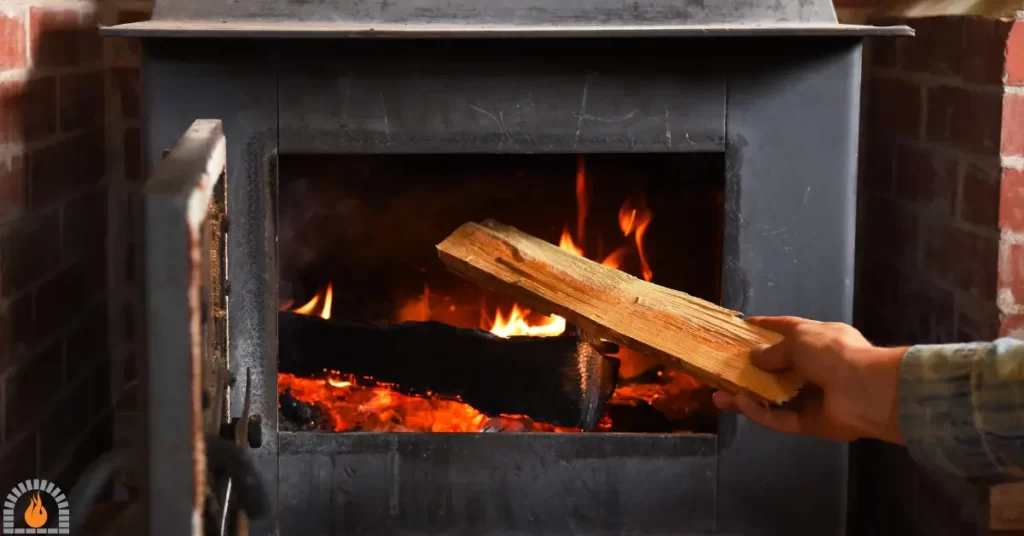
4) Cherry Wood
Due to its unique characteristics, cherry wood is a popular choice for burning in fireplaces.
Here are the main characteristics of cherry wood as a burning wood:
- Heat Output: Cherry wood produces a good amount of heat when burned. It has a moderate to high heat output, making it suitable for heating smaller to medium-sized spaces.
- Aesthetic Appeal: Cherry wood burns with a beautiful flame and produces a pleasant aroma, adding to the overall ambiance of the fire. The flames have a reddish hue, creating an inviting and cozy atmosphere.
- Burn Rate: Cherry wood has a moderate burn rate, meaning it doesn’t burn too quickly or too slowly. It provides a steady and long-lasting burn, allowing for extended enjoyment of the fire.
- Coaling Properties: When burned, cherry wood creates a good amount of hot coals that can be used to maintain a fire or start a new one. These coals have a consistent and sustained heat output, aiding in the efficiency of the fire.
- Smoke and Spark Production: Compared to other woods, cherry wood produces minimal smoke and sparks when properly seasoned and dry. This can benefit indoor fireplaces, reducing the risk of excessive smoke or potential hazards from flying sparks.
- BTU: (British Thermal Units) and smoke percentage can vary based on the burned cherry wood’s moisture content, density, and overall quality. However, on average, cherry wood has an approximate BTU rating of 20 MBTU/cord. As for smoke percentage, when properly seasoned, cherry wood tends to have a lower smoke output than other hardwoods. However, ensuring proper ventilation when burning any wood indoors is still essential.
5) Ash Wood
Ash wood is widely regarded as an excellent choice for burning in a fireplace due to its desirable characteristics.
Here are the key features of Ash wood as a burning wood:
- BTU (British Thermal Unit): Ash wood is known to have a high BTU output, which refers to the amount of heat generated when burned. On average, Ash wood has a BTU rating of around 19.9 MBTU/cord. This high BTU value ensures a strong and consistent heat output, making it effective for heating.
- Low Moisture Content: Ash wood tends to have a low moisture content, making it relatively easy to ignite. When compared to other types of firewood, the lower moisture content of Ash wood allows for a more efficient and cleaner burn.
- Minimal Smoke: Ash wood produces minimal smoke when burned, making it an ideal choice for indoor fireplaces. Low smoke production contributes to a cleaner and healthier indoor environment and reduces the risk of creosote buildup in chimneys.
- Long Burn Time: Ash wood provides a sustained and long-lasting burn. It has a dense composition, which means it can burn for extended periods without needing constant refueling. This characteristic makes Ash wood suitable for overnight burns or when you want to maintain a fire for an extended duration.
- Easy to Split: Ash wood is relatively easy to split, making it convenient for those who prefer to split their firewood manually. The wood has straight grains and a favorable density, making it less challenging to work with when compared to some other hardwood varieties.
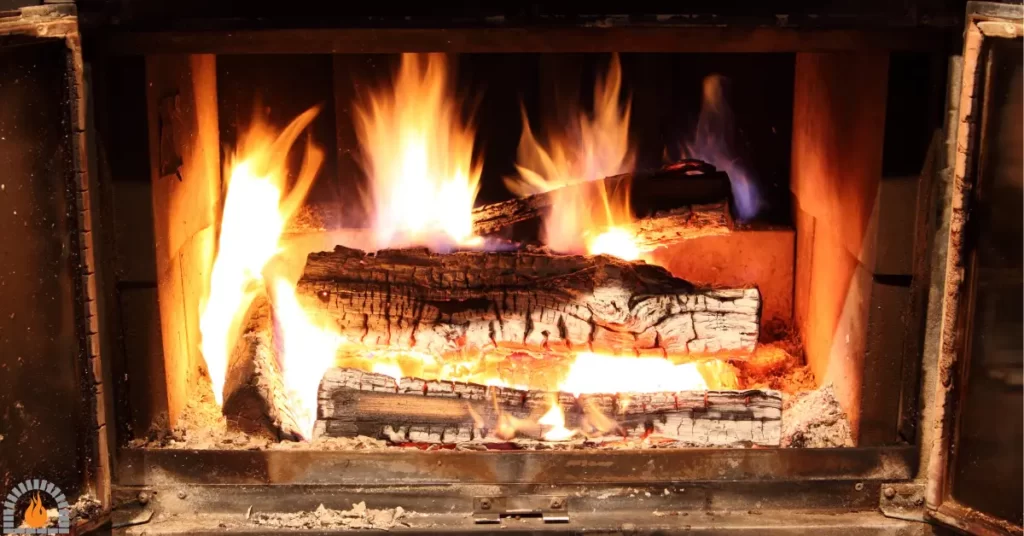
6) Birch Wood
Birch wood is known for its excellent qualities as a burning wood for fireplaces. Here are the characteristics of Birch wood and the corresponding BTU (British Thermal Unit) and smoke percentage:
- BTU: Birch wood has a high BTU rating, which refers to the heat generated by burning a specific type of wood. On average, Birch wood has a BTU rating of approximately 20.3 MBTU/cord. This high BTU value makes Birch wood an excellent choice for heating, as it produces significant heat.
- Smoke Production: Birch wood produces relatively low levels of smoke when burned. It is considered a hardwood, and hardwoods generally produce less smoke than softwoods. However, it’s important to note that the smoke production can vary depending on the moisture content of the wood. Dry Birch wood produces less smoke than freshly cut or wet wood.
- Flame Characteristics: Birch wood burns with a bright and lively flame. It ignites easily and produces a steady and consistent heat output. The flames have a beautiful yellow-orange color, providing an inviting and cozy atmosphere in your fireplace.
- Aroma: Birch wood emits a pleasant aroma that adds to the overall ambiance when burned. The scent is often described as mildly sweet and aromatic, enhancing the enjoyment of the fire.
- Burn Time: Birch wood burns relatively quickly compared to some other hardwoods. It can provide a good burst of heat but may require more frequent refueling than denser woods such as oak or maple.
- Sparking: Birch wood produces minimal sparking, making it safer to use in fireplaces. However, taking necessary precautions to prevent sparks from reaching flammable materials nearby is still important.
7) Douglas Fir
Douglas Fir wood is commonly used as a burning wood for fireplaces due to its favorable characteristics. Here are the main features of Douglas Fir wood as a burning wood:
- BTU (British Thermal Unit): Douglas Fir wood has a high heat value, making it an efficient choice for fireplaces. It provides approximately 18.1 MBTU/cord of seasoned wood.
- Density: Douglas Fir wood is known for its high density, contributing to its slow and steady burn. This dense wood produces long-lasting and consistent heat, making it ideal for maintaining a warm fire.
- Ignition: Douglas Fir wood ignites relatively easily, especially when properly seasoned. It catches fire quickly and burns steadily, requiring less effort to start and maintain a fire.
- Flame Characteristics: When burning, Douglas Fir wood produces a vibrant flame with a pleasant aroma. It creates a cozy and inviting atmosphere in the room.
- Smoke Production: Douglas Fir wood produces moderate to high amounts of smoke compared to other hardwoods. Ensuring proper ventilation when burning Douglas Fir is important to minimize smoke buildup in the room.
- Resin Content: Douglas Fir wood contains a moderate amount of resin, contributing to its high energy content, but it can also increase creosote buildup in the chimney. Regular chimney maintenance is recommended to prevent the risk of chimney fires.
- Coaling Properties: Douglas Fir wood has good coaling properties, forming a bed of hot embers that radiate heat even after the flames have died. This can help maintain warmth in the fireplace and reduce the need for constant refueling.
8) Apple Wood
Apple wood is a popular choice for burning in a fireplace due to its desirable characteristics. Here are the characteristics of apple wood as a burning wood:
- High Heat Output: Apple wood is known for its high BTU (British Thermal Unit) content, which measures the heat energy released during combustion. It provides a substantial amount of heat when burned, making it efficient for heating.
- Pleasant Aroma: One of the distinctive qualities of apple wood is its pleasant, sweet aroma. When burned, it releases a fragrant smoke that can enhance the ambiance of your home and create an inviting atmosphere.
- Slow Burning: Apple wood burns steadily, which is ideal for long-lasting fires. Its dense nature allows it to provide sustained heat over an extended period, reducing the need for frequent log replenishment.
- Low Smoke Production: Compared to other firewood types, apple wood produces minimal smoke when burned. This is advantageous for indoor fireplaces, as it reduces the risk of indoor air pollution and minimizes the buildup of soot and creosote in the chimney.
- Good Coaling: Coaling refers to the formation of glowing embers left behind after the wood has burned. Apple wood has excellent coaling properties, producing a bed of hot embers that can help ignite new logs and maintain a consistent fire.
- Suitable for Cooking: Due to its mild and fruity flavor, apple wood is a favored choice for smoking and grilling food. It imparts a delicately smoky taste to the food and pairs well with various meats, making it popular among barbecue enthusiasts.
- BTU and Smoke Percentage: The BTU content of apple wood can vary depending on moisture content and wood density. On average, it provides approximately 26.5 MBTU/cord of wood (a cord being a unit of measurement for firewood, equivalent to a stack measuring 4 feet high, 4 feet wide, and 8 feet long).
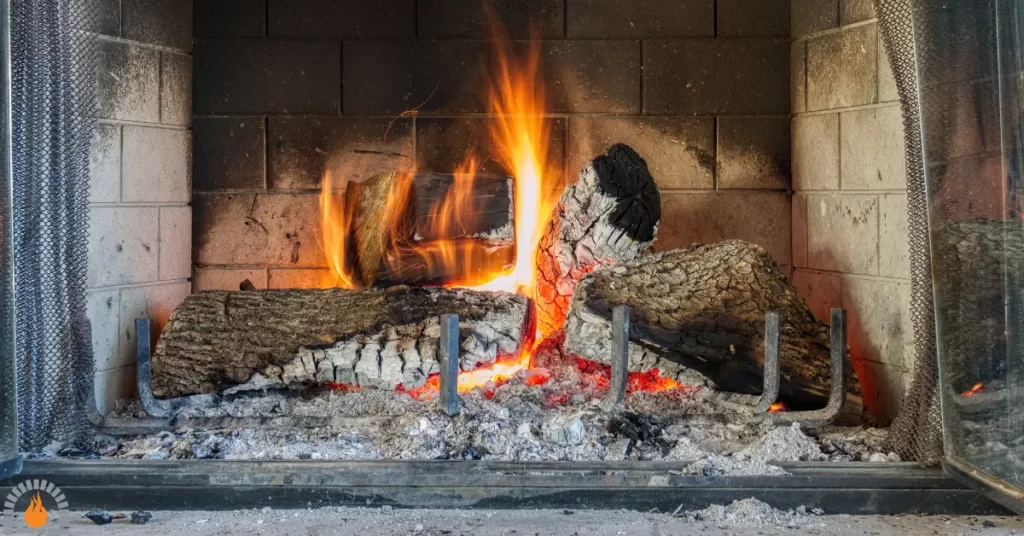
9) Pear Wood
Pear wood is known for its favorable characteristics as a burning wood for fireplaces. Here are some of its notable features:
- BTU Value: Pear wood has a moderate to high BTU (British Thermal Unit) value, which measures the heat energy released when the wood is burned. While the BTU value can vary depending on moisture content and wood density, pear wood typically falls within 27.9 MBTU/cord. This makes it a good choice for generating efficient and consistent heat in a fireplace.
- Density: Pear wood has a moderate density, meaning it burns slowly and provides a longer-lasting fire than softer woods. This characteristic is particularly desirable for fireplaces, ensuring a steady and sustained heat output.
- Ignition and Flame: Pear wood is relatively easy to ignite, making it convenient to start a fire in a fireplace. Once ignited, it produces a lively flame that provides a warm and cozy ambiance.
- Aroma: When burned, pear wood emits a pleasant and mildly sweet aroma. This can enhance the room’s overall atmosphere and create a comforting environment.
- Smoke and Residue: Pear wood produces minimal smoke when burned properly. It tends to burn cleanly, with reduced levels of soot and residue. This makes it an excellent choice for individuals who prefer a cleaner and less smoky fire.
- It is important to note that while pear wood has several advantages as a burning wood, it is crucial to ensure that it is properly seasoned and has a moisture content of around 20% or less. This helps maximize the efficiency of the burn and minimizes the production of smoke and creosote buildup.
You May Also Like To Read:
Affiliate Disclosure: Fireplaceadviser.com is a participant in the Amazon Services LLC Associates Program. We may earn a commission when you click on certain links on this site and purchase.

Hello!! I am Jamal Khan. I often fix my home electric heaters and gas stove problems and research the common issues in the heating units to improve my knowledge and expertise. The aim of establishing fireplaceadviser.com is to share my expertise and knowledge with my audience.











